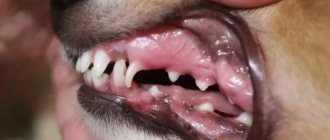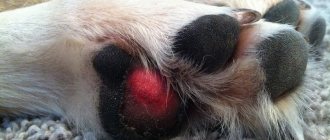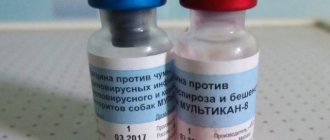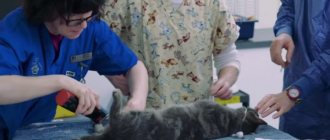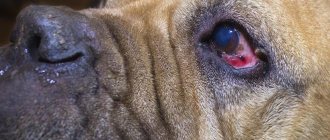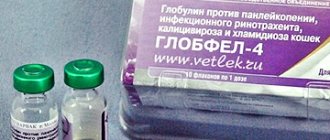Why is it dangerous?
The danger of cryptorchidism lies in the fact that the testis, located inside the body, and not in the scrotum, is not in a suitable temperature environment . The natural temperature of the scrotum is lower than body temperature, so the testis located in the abdominal cavity is constantly overheated.
Because of this, irreversible changes occur in it, which can result in the appearance of a tumor on this organ in a male dog by the age of 5. The likelihood of such a neoplasm appearing in cryptorchids is an order of magnitude higher than in healthy animals. But even if a tumor does not appear, such dogs have problems with the quality and quantity of sperm , some may be sterile, others may have reduced libido. In addition, cryptorchidism is often combined with other developmental anomalies, for example, with umbilical and inguinal hernia, as well as joint pathologies.
Kinds
Cryptorchidism in dogs can be true or false, the second is much more common than the first. The difference between them is that with false cryptorchidism, the testis, regardless of where in the inguinal canal it is located, can be lowered into the scrotum manually. In case of true pathology, this can only be done surgically.
REFERENCE! Cryptorchidism often occurs in puppies up to 0.5 years old and is in a sense normal - the testicle has simply not yet had time to descend into its proper place. If the dog is older, and this did not happen, then you need to start treatment.
It happens that the already descended testis rises back along the inguinal canal. This occurs due to slow growth of the spermatic cord, which simply pulls it out of the scrotum. In addition, the testes may be underdeveloped, not reaching normal size by a certain age of the dog, they may also atrophy or be located in an atypical place - in the perineum, on the inner thigh (ectopia of the testis).
All of the listed types belong to congenital cryptorchidism, but this pathology can also be acquired . Its cause is blunt trauma to the scrotum, as a result of which the testicle is displaced back into the inguinal canal.
Unilateral
Unilateral cryptorchidism is the failure of one, left or right, testicle to descend into the scrotum. Since one of them is still in its place, the pathology of this type leads to infertility much less often than the next type.
Bilateral
Bilateral cryptorchidism in dogs is diagnosed if both testes have not descended into the scrotum. Less common than unilateral.
Cryptorchidism in dogs
In male dogs of any breed, both testicles descend into the scrotum by six months. Before this, they were located in the abdomen, and with age they descend down the seminiferous tubule. From this moment the puppy becomes sexually mature, i.e. can mate individuals of the opposite sex and have offspring. At the age of six months, puppies must be checked by a veterinarian to ensure the correct location of the testicles.
Unfortunately, not all male dogs have the correct development of their genital organs. It also happens that one or two testicles “get stuck” under the pelvic bone and do not descend completely. This disease is called cryptorchidism. Cryptorchidism in dogs is considered a hereditary disease and is transmitted from generation to generation not only through a male, but also through a female. There are two types of cryptorchidism: unilateral and bilateral.
With bilateral cryptorchidism, both testicles do not descend, the male becomes, as it were, sterilized and cannot have offspring. For the dog itself, such a disease may end in an unfavorable outcome in the form of degeneration of the testicles remaining in the abdomen into a malignant formation.
We recommend reading: Cat Saliva Flows Treatment
With unilateral cryptorchidism, only one testicle does not descend, so the pet can mate and have offspring. The offspring will also be cryptorchids, not all of them, of course, but they will be. According to the rules of the RKF, such males are not allowed for mating.
Unscrupulous breeders often hide the fact that the puppy’s parents had or have cryptorchid. Moreover, in order for a male with cryptorchidism to be allowed to breed, such breeders go to all sorts of tricks, such as plastic surgery to sew in an artificial testicle. In this case, when assessing a male dog, the commission probes both testicles and gives the go-ahead for mating. In fact, the dog is defective.
Officially, such operations are prohibited both abroad and in Russia, and the veterinarian who performed it will suffer serious punishment, including deprivation of practice. In fact, such operations are performed, but illegally. Just like operations to set the ears (not correction, but plastic surgery, which is also illegal). When buying a puppy for the purpose of further breeding, you should pay the most serious attention to its pedigree. There should not be a single animal suffering from cryptorchidism. It is necessary to look through as many generations of relatives of this puppy as possible, because such operations have not been done before. Those breeders who have nothing to hide will show you all the documents that you want to see.
Males with cryptorchidism must be castrated and every veterinarian will definitely offer this to you. For bilateral cryptorchids this will be a strip operation, and for unilateral cryptorchids it will be surgery plus castration. This must be done, as I already wrote, because of the possibility of the appearance of malignant tumors.
If you did not intend to breed dogs and breed your own, then the diagnosis of cryptorchidism should not sound like a death sentence. Surgery, castration and your dog will delight you for many years to come. If your goal is further breeding, then you have two options: look at pedigrees of several generations or buy a dog over six months of age (some boys have testicles that descend earlier) and only after it has been examined by a veterinarian.
And I would also like to add that massage, medications and other methods of mechanical descent of the testicle rarely lead to success. It is even possible that the testicle will descend, but after an illness and even a change of teeth it will go up again. Everything should happen naturally, not artificially.
My King had one testicle that did not descend and at one time he had strip surgery and castration. The other day my child turned 11 years old. This is absolutely not an aggressive dog and never has been. He is cheerful, lively, playful, spoiled and in character is very far from being a “rug”, as some are afraid. He doesn't lie around and doesn't overeat. He guards, barks, growls at strangers and does not allow inappropriate individuals to approach me. He is patient with children and is friendly with all dogs. He never rushes first, but if the dog rushes at him, he will respond as expected. The dog as a whole is simply wonderful and not because he is mine. I can only say one thing: if cryptorchidism is detected, there is no need to be afraid of castration and refuse surgery.
If anyone has encountered the problem of cryptorchidism, please sign up. Tell us how you got out of this situation and how cryptorchidism or castration affected your dog's health and character.
With unilateral cryptorchidism, only one testicle does not descend, so the pet can mate and have offspring. The offspring will also be cryptorchids, not all of them, of course, but they will be. According to the rules of the RKF, such males are not allowed for mating.
Causes
False cryptorchidism develops due to increased tone of the muscle that lifts the testicle or due to weakness of the ligaments that hold it in place, as well as due to the wide inguinal canal through which the testicle easily rises to the top.
Congenital true cryptorchidism develops due to the fact that the dog:
- large testis;
- narrow inguinal canal or its opening;
- short spermatic cord;
- underdeveloped testis;
- underdeveloped scrotum.
The cause of these anomalies themselves is disorders of embryonic development, which are inherited genetically. This is confirmed by the fact that there are much more cryptorchids among purebred males than among outbred males. Another reason for congenital cryptorchidism is a lack of vitamins in the diet of a pregnant bitch, especially A and B9.
In growing puppies, cryptorchidism can be caused by hormonal imbalances or infectious inflammation of one or all of the components involved in the movement of the testis into the scrotum.
Why does the disease affect animals?
Currently, there are many different reasons for the development of this disease in puppies. This may include:
- the size of the testis (it can be greatly enlarged and not pass into the seed ring);
- narrowing of the inguinal canal, which also results in the inability of the testicle to descend;
- Some male dogs have an underdeveloped scrotum, and this sometimes causes cryptorchidism.
To understand the essence of the disease, you need to know how the testicle develops and how it descends in accordance with the norms.
As a rule, in newly born puppies, the testes are located in the abdominal cavity. But in the future, the action of hormones leads to a natural descent of the testicles into the scrotum. Therefore, if there are not enough hormones, it can slow down or stop the movement of the testis. The disease can also develop due to any inflammatory process with normal hormonal levels.
We recommend reading: Paw Pad Diseases in Cats Photos
Basically, the disease develops due to a failure of embryonic development. How the dog’s pregnancy progresses plays a big role here. For example, a pregnant dog should be provided with additional vitamins and minerals.
Symptoms and diagnosis
Usually cryptorchidism does not cause any inconvenience to a male dog, and it can only be determined visually by the absence of a testis where it is needed. But there are other symptoms :
- abdominal pain;
- redness and swelling of the scrotum;
- hair loss on an empty scrotum;
- dark coloration of the external genitalia.
An accurate diagnosis is made in a veterinary clinic. First, the doctor conducts an examination, palpates the scrotum, and if the testis is not found in it, then the places where ectopic testes may be located are examined. If the testicle is found in the inguinal canal, then they try to lower it into the scrotum manually. This manipulation makes it possible to distinguish false cryptorchidism from true one. If the testes cannot be palpated, then their location is determined by ultrasound .
But ultrasound diagnostics is not an extremely accurate method for determining cryptorchidism, since inguinal lymph nodes, gases in the intestines, etc. can be mistaken for the testes, so other methods are also used. For example, a hormonal test using gonadotropin can detect pathology more successfully. Its essence is to compare the level of testosterone in the blood before and after the injection. An increase in hormone concentration in the second sample indicates cryptorchidism. If the testis is intra-abdominal, a laparoscopic diagnostic method is used.
Features of cryptorchid castration
Undescended testicles are most likely to lead to the development of an oncological process of the testis - semenoma. It is for this reason that undescended testicles need to be removed.
The surgical intervention is performed as follows:
- the animal must be given anesthesia;
- then an incision is made on the abdominal area;
- through the incision, the doctor removes the testis from the groin area;
- the testis is removed;
- the second testis is removed as during normal castration.
Castration has many pitfalls that every owner of a tailed dog should be aware of. This procedure may further cause the development of complications that can negatively affect the health of the animal. To avoid this, you should first consult with a veterinarian and have your pet examined. Also, after the operation, it is necessary to provide full care, which the doctor will have to tell you about. TO
Possible future consequences
A male dog with unilateral cryptorchidism can live his entire life quite normally, not get sick, and even have offspring. Of course, this applies only to non-pedigreed animals, because purebred animals with such a diagnosis are excluded from breeding in order not to pass on the pathology by inheritance. And one of his descendants will definitely have it, so there is no need to risk it.
Cryptorchidism can threaten the dog itself with health problems - the formation of a tumor on the testis already at a fairly young age. Another danger is that if the testis is located in the abdominal cavity, then, although rarely, the spermatic cord can become twisted, which causes severe pain and other complications.
Treatment
Treatment of this pathology is carried out in two ways: conservative and surgical . Conservative is only suitable for young dogs whose inguinal canal is not yet closed. One of the ways to treat cryptorchidism in puppies up to six months of age is regular massage. This procedure allows one to correct the defect in approximately 1/5 of male dogs with this pathology.
Medication
To treat cryptorchidism caused by hormonal disorders, appropriate medications are used. Often this is choriogonadotropin or gonadotropin-releasing hormone, which stimulate the production of luteotropic hormone. This substance causes the testis to move along the inguinal canal. The drug treatment method has limitations: if the cause of cryptorchidism is not a hormonal imbalance, it is not used, since the effect of hormones on the animal body is still poorly understood and can subsequently cause significant harm.
Operation
True cryptorchidism is treated surgically: an operation (orchipexy) is performed, during which the testis is forcibly lowered into the scrotum. It is often recommended for purebred dogs that are planned to be shown at exhibitions.
The operation is performed under general anesthesia. The animal is euthanized, the surgeon cuts its abdomen, finds the testis, lowers it into the scrotum and sutures the incision. This operation is not difficult and is completely safe. Dogs tolerate it well and recover quickly in most cases. There is evidence that a third of the operated male dogs have improved sperm quality, but, nevertheless, they are not allowed for breeding, even if they have an excellent pedigree. Therefore, orchiopexy is suitable for cosmetically improving the appearance of dogs rather than restoring their value to the breed.
Reviews about the operation
Oleg, 28 years old, Moscow
I think that surgery on undescended testes in cryptorchid dogs is the best treatment option of all. Massage takes a long time and is ineffective; hormonal therapy is not always suitable. The operation solves everything in one day. Of course, you then need to take care of the animal until it recovers, but this is better than facing the fact that it will get sick when it grows up.
Maxim, 44 years old, Krasnodar
Surgery, in my opinion, is the optimal solution to the problem. The benefits are double: it is convenient for the owner and the animal can be kept healthy. The only pity is that such dogs can no longer be used for breeding.
Castration option
Castration is another treatment option for cryptorchidism. It is carried out at the request of the owner, who can choose this particular method of therapy. Before the operation, blood and urine tests are taken from the animal, an X-ray examination is performed, and the necessary vaccinations are given. Direct preparation for the intervention is as follows :
- deworming, which is carried out 2 weeks before surgery;
- swimming per day;
- restriction in food and water for 0.5 days.
The operation is performed under general anesthesia, using painkillers and sedatives. Depending on the location of the testis, non-cavitary or abdominal surgery may be necessary. Castration takes place quickly; all vital reflexes, such as appetite, urination, defecation and activity in the animal are restored within 24 hours after the operation. In most cases, a neutered male dog is immediately sent home, where he is given the necessary care.
Every day the seam is treated with antiseptic drugs prescribed by a doctor. If necessary, the animal is given painkillers. To keep the seam clean, a bandage is applied to it and secured with a special blanket. A collar is placed around the dog's neck to prevent it from reaching the incision and licking off the medication. The stitches are removed after about 2 weeks.
ATTENTION! If during the recovery period the male dog has a fever, the suture becomes red, swollen, or pus begins to ooze from it, you should immediately show him to the veterinarian.
How is postoperative care provided?
The most commonly used anesthesia is muscle relaxants, drug-induced sleep, and epidural anesthesia. The timing of the animal's awakening is purely individual. The owner takes the animal from the veterinary clinic only at the moment of complete awakening. Owners are given detailed recommendations on post-operative care for the animal, and painkillers are also prescribed for use at home.
Upon arrival home, the dog should be placed in a warm, low place.
When applying external sutures, they should be protected from the animal’s licking either with a blanket or a protective collar (Elizabethan).
Treatment of seams is recommended with specialized sprays (Ranosol/Monclavit/Migstim type) once a day, and the treatment is carried out gently; in no case should you rub the seam, remove crusts, only gently wipe/soak. Removing the suture
material is produced in a clinical setting for 7-10 days (depending on the degree of healing).
It is also possible to apply a cosmetic suture, in which the suture material itself does not need to be removed, but such a suture also requires care. The type of wound closure depends on the animal's skin and the physician's preference.
Prevention
In most cases, cryptorchidism in dogs is a hereditary pathology, the occurrence of which is almost impossible to influence. The only means of prevention is a balanced and nutritious diet for the pregnant bitch, especially at the end of the period of gestation. In addition, the animal should only be paired with healthy males whose ancestors did not suffer from a similar problem.
As for acquired cryptorchidism, associated with injuries and infections, measures to prevent it include keeping the puppy in a warm and dry room, mandatory walks, a well-chosen diet, and timely vaccinations.
